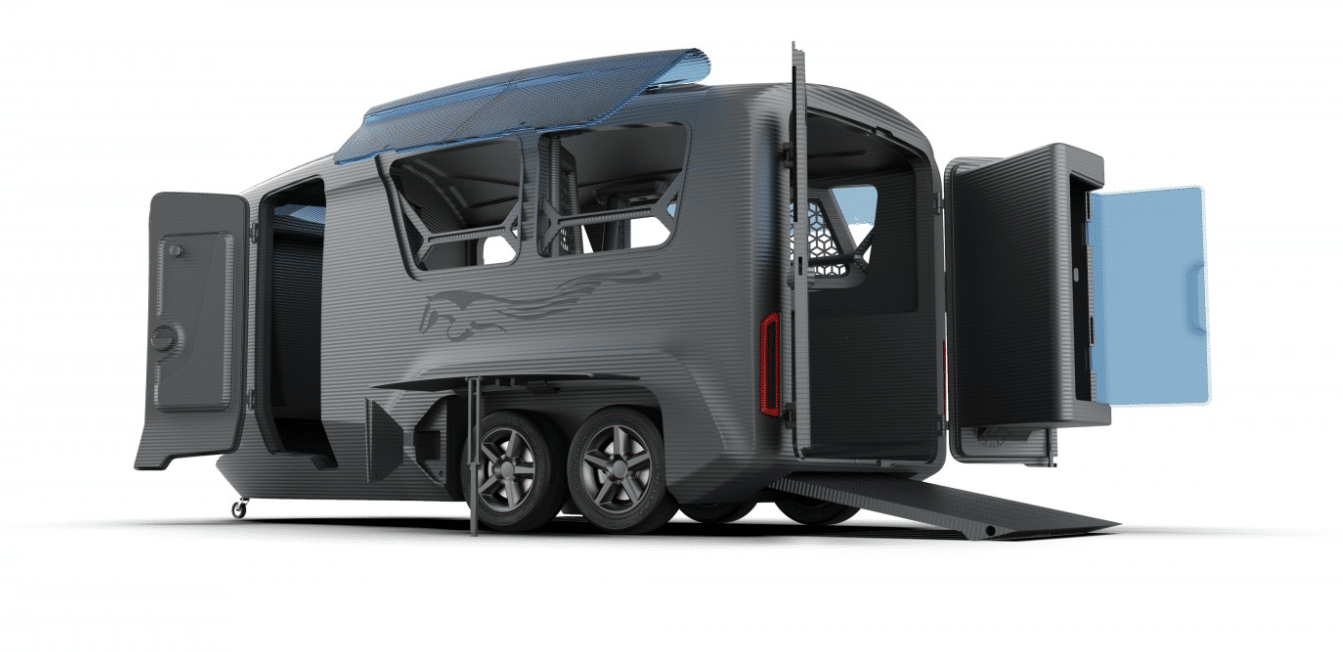3D-Printed Horse Trailer Safety: Is It Possible?

When you first think of a 3D-printed horse trailer, most people are in shock. Since it’s a brand new concept - a lot of the reaction that we have received from consumers is that it LOOKS really cool, but is it safe? Can a 3D-printed horse trailer function just as well, if not better than my traditionally manufactured horse trailer?
As we’ve been announcing the launch of the Double D Trailers patent pending 3D-printed SafeTack Reverse 2 Horse Bumper Pull Carbon trailer model, we’ve noticed that there are a lot of common questions and concerns arising from consumers about 3D-printed horse trailer safety in many aspects such as maintenance, durability loading/unloading horses, towing, windows, and air flow. In this article, we’ll cover some of the most frequent FAQ’s we’ve received about 3D-printed horse trailer safety.
#1: How Long Does it Take to Print a 3D Horse Trailer?
As we’ve been working diligently with our team of engineers, they are anticipating that with the amount of materials required it will take between 15-20 hours to 3D print this horse trailer model. In comparison to the horse trailer industry current lead times due to supply chain shortages and staffing limitations, this is an astronomical difference. At the time of this writing, the Double D Trailers lead time at the production factory is between 8-10 months. Because of the fact that these horse trailers can be printed so quickly and all in one location, we are really excited that customers will be a part of their production journey. We plan to have cameras set up within the factory so that you can watch your own trailer being printed in real-time!
#2: How Long Will a 3D-Printed Horse Trailer Last?
When it comes to the area of longevity, first you’ll need to know what materials are used in the printing production process. For our Carbon trailer model, we will be using a blend of polycarbonate, carbon fiber, and fiberglass. It was extremely important to us in our material selection process that we chose materials that were both forgiving AND durable. The reason behind this is that if a horse kicks or panics inside of the trailer, we want to make sure that the material is forgiving enough that the horse does not get injured, but also strong enough so that the horse can’t kick through the trailer.
Polycarbonate is an extremely strong thermoplastic that is commonly used in the roofing of houses. In the construction industry where polycarbonate is most frequently used, it’s reported to last upwards of 30 years.
Fiberglass is really common in all aspects of manufacturing. Fiberglass is most commonly used in boats, because of its strong structural integrity. Fiberglass has been known to last up to 50 years (even when used in the water).
Similarly to fiberglass, carbon fiber is a form of graphite and it is a really tough material. Unless the material is damaged, carbon constructed materials can last indefinitely.
The Safetack Reverse Carbon chassis will be carbon fiber mixed with polycarbonate and the remainder of the trailer including sidewalls, roof, doors and glass will be polycarbonate and fiberglass mixed materia.
#3: Horse Trailer Safety with Accidents: What Happens If I Wreck a 3D-Printed Horse Trailer?
Another frequent concern that we have heard from consumers is how a 3D-printed horse trailer will withstand an accident. Here is the brutally honest truth: a 3D-printed horse trailer will withstand a severe accident just as any other horse trailer.
It’s a common misconception that polycarbonate is a cheap plastic that is really flimsy, and that’s just not the case. The average tensile strength of polycarbonate is approximately 7000 lbs psi, which means that it takes around 7000 lbs per square inch to break polycarbonate.
Horse trailer accidents are scary, and the most important thing to look for on a trailer is the safety features that it has. Features to look out for in a horse trailer when it comes to keeping you and your horses as safe as possible in the event of an accident include:
-
Multiple Access Doors
-
Strong Trailer Frame
-
Quick Release Dividers
Read More: How to Safely Handle a Horse Trailer Accident
#4: How Will My Horses Get Air Flow?
We had a few clients that have reached out to us asking how the Carbon trailer model is insulated. Most people asked how in the world that their horses would stay cool when traveling when the windows on this trailer model are not able to drop-down. Our first answer to this question is that when it comes to horse trailer safety 101, horses should never be riding in a horse trailer down the road when the windows are not latched and secured.
Traveling with the windows down can be extremely dangerous for horses. Horses are subject to road noise and road debris flying up. In addition, we have heard worst-case scenarios from clients; such as horses getting beheaded when people travel with the windows and bars down.
The 3D-printed SafeTack Reverse 2 Horse Bumper Pull Carbon model will have a proprietary air flow system with ducts that are printed directly into the frame of the trailer. This airflow setup will allow for each horse to receive ample air. This will be a pass through system so that horses will continually have fresh air and ride comfortable, cool, and quiet.
#5: How Will the 3D Trailer Withstand Extreme Temps?
It’s no secret that when you 3D print something, there is plastic involved. However, people hear the word “plastic” and run away. Plastics, specifically the thermoplastics used in 3D printing have come a long way. There are many options available to choose from, and we researched and decided with our team of engineers that the best thermoplastic to use for the 3D horse trailer design was polycarbonate. One of the main reasons that we chose to use polycarbonate over other plastic material options is because it provides optimal horse trailer safety. Polycarbonate is able to maintain its structural integrity and chemical properties even in a wide range of temperatures.
Polycarbonate is able to withstand temperatures of upwards of 270 degrees F for many hours and -40 degrees F for many hours. This temperature range allows for polycarbonate to maintain full integrity, whereas with other popular construction materials such as aluminum, aluminum starts to lose its integrity and strength factors between 200-250 degrees F.
#6: What Happens If I Blow a Tire?
A lot of people have been concerned about the horse trailer safety aspect of the event of a blown tire with a 3D-printed horse trailer. One unique feature about our Carbon 3D trailer is the wheel cover that we have covering the tires. This panel cover really serves two purposes: 1) horse trailer safety, and 2) convenience (we’ll talk more about the convenience factor in another article). If you have ever seen a horse trailer on the road that had a blown tire - it’s an absolute nightmare. On most traditional horse trailer models, there will not be a panel that is covering the tires. In a lot of scenarios the tire completely comes off, can bounce around and hit the trailer, create rubber marks and dents all throughout the trailer exterior.
With the 3D-printed horse trailer model, a blown tire will certainly cause damage. However, the damage will be contained to the wheel cover panel. The panel is easily removed, so that if a tire blows and the panel is damaged, you can simply pop off the panel to change your tire - and the rest of your trailer will remain in great shape. We can print and send replacement panels to be easily reinstalled.
Next Topic: How Loading and Unloading Horses on a 3D-Printed Horse Trailer Works

